Looking to up your cold email game? Discover 7 battle-tested strategies to skyrocket your open rates, backed by insights from 10,000+ real-world campaigns. Plus, get instant inspiration with our curated list of 120+ high-converting subject lines.
Imagine this: you’ve just sent 100 cold emails. Your product is amazing. Your sales pitch is impeccable. And yet… all you get is crickets 🦗
Why? Because 80% of those messages were never even opened. Ouch. That’s a lot of money left on the table.
Now, what if I told you there’s a set of magic words that could triple your open rates? A secret code that turns “Delete” into “Let’s talk”?
Over the past 6 years, Mailmeteor has sent 10,000+ cold email campaigns. And we’ve learned a thing or two along the way.
In this guide, we’re not just sharing 120+ cold email subject lines that work. We’re handing you the keys to your prospects’ inboxes.
Whether you’re a sales ninja, or just someone trying to break through the noise, you’re about to discover how 5 words or less can revolutionize your outreach game.
Ready to turn cold prospects into hot leads? Then let’s crack the code together and help you write emails that actually convert.
7 strategies to write effective cold email subject lines
In this section, we’re going to explore 7 proven strategies to create effective cold email subject lines that get opens, clicks, and replies. These aren’t just random phrases. They’re based on psychological triggers, carefully crafted to pique curiosity, spark urgency, and compel action.
1. Personalized subject lines

When to use it:
According to Hubspot, cold emails with a personalized subject line get 26% more opens. So make sure to craft tailored subject lines when you have specific information about your recipient or their company.
Why it works:
Personalization cuts through the noise of generic emails. It shows you’ve put effort into understanding the recipient, making them more likely to reciprocate by opening and reading your message.
Examples:
- [Name], quick question about [Company]’s approach to [Challenge]
- Your LinkedIn post on [Topic] caught my eye, [Name]
- [Mutual Connection] suggested I reach out to you, [Name]
- Congrats on [Achievement], [Name]!
- [Name], your thoughts on [Industry Trend]?
- Saw your team is hiring for [Position] - can I help?
- [Name], [Competitor] is using our solution - interested?
- Loved your talk at [Event], [Name]
- Your recent article on [Topic] resonated with me, [Name]
- [Name], how are you handling [Challenge]?
- Quick idea for [Company]’s [Department] team, [Name]
- [Name], could [Product] benefit [Company] like it did for [Competitor]?
- Noticed [Company]’s focus on [Area] - let’s talk
- [Competitor] is achieving [Result] - here’s how [Company] can too
- [Name], noticed [Company] is expanding - can we assist?
- How [Company] can stay ahead in [Trend]
- [Name], thoughts on collaborating to solve [Problem]?
- [Company]’s [Department] might find this useful
2. Question-based subject lines
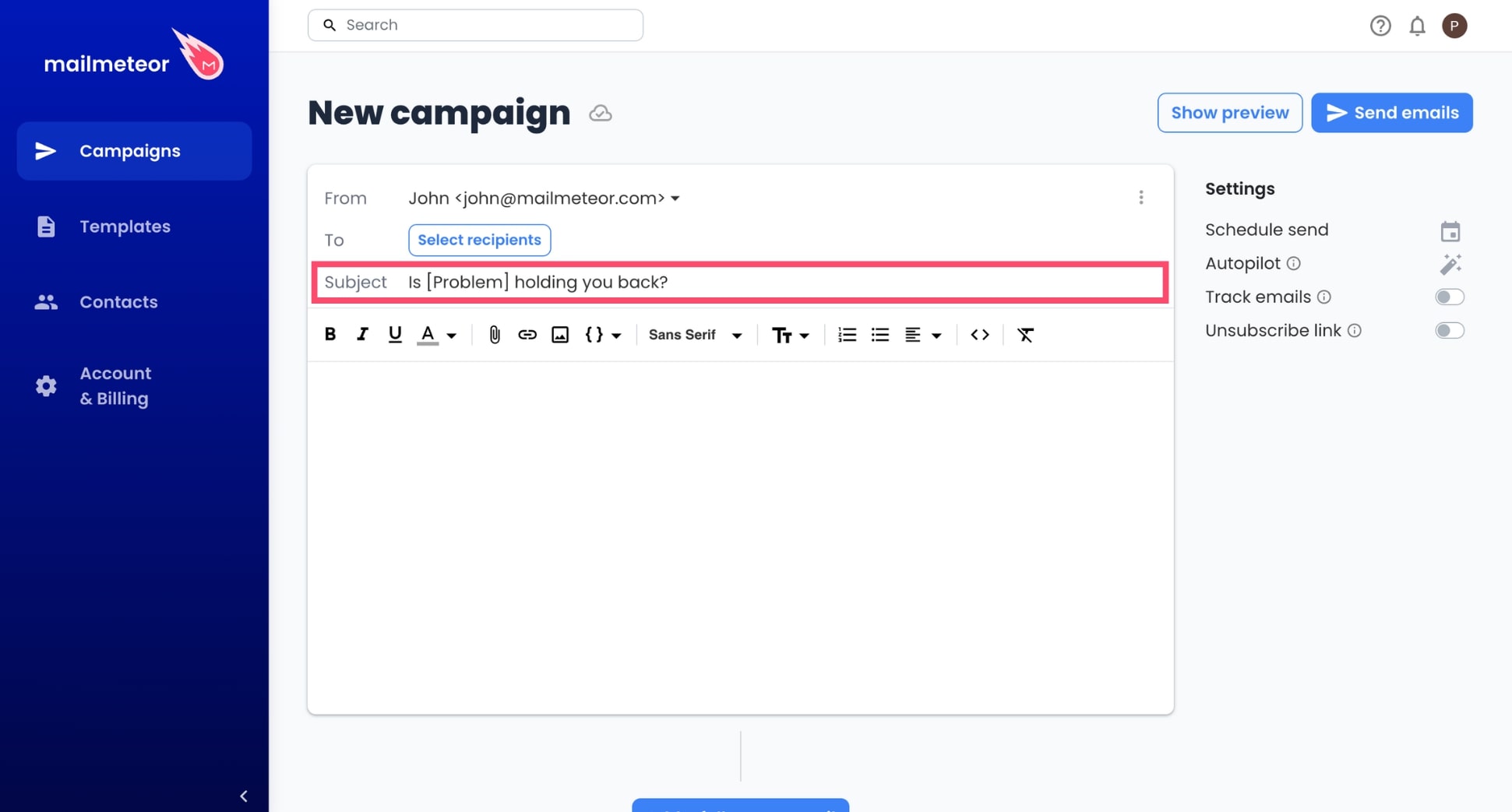
When to use it:
Ask a question in your cold email subject line when you want to pique your recipient’s curiosity, or highlight a problem they might be facing. This works great when you can find a question that relates to the recipient’s role, industry, or challenges.
Why it works:
Questions create an information gap that compels recipients to open the email to find the answer. A well-crafted question can also make the recipient feel that you understand their challenges and have valuable insights to offer.
Examples:
- Want to increase [Metric] by 30%?
- How does [Company] handle [Process]?
- Curious about the future of [Industry]?
- Looking to streamline your [Process]?
- Need help with [Goal]?
- Have you considered [Approach] for [Problem]?
- Is [Problem] holding you back?
- Interested in cutting [Expense] by 25%?
- Want to know what [Competitor] is doing differently?
- Are you prepared for [Upcoming Industry Change]?
- How satisfied are you with [Current Solution]?
- What’s holding [Company] back from reaching [Specific Goal]?
- Are you making the most of [Opportunity] in [Industry]?
- How secure is your [Aspect of Business] against [Risk]?
- Are you leveraging [Tool] to its full potential?
- How can [Company] improve [Metric] by year-end?
- Are you capitalizing on [Trend]?
- How can [Company] optimize [Aspect of Business]?
3. Pain point subject lines
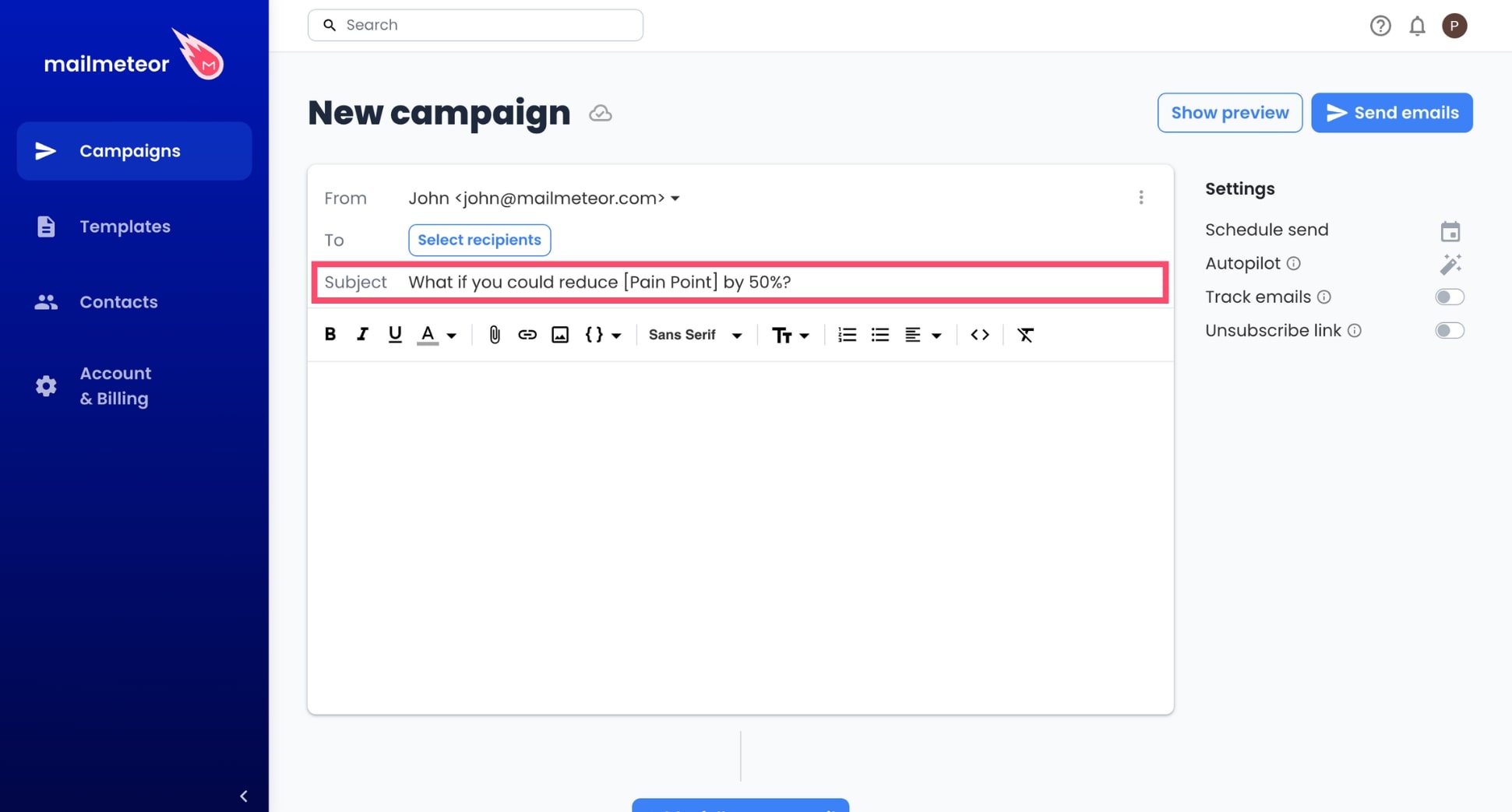
When to use it:
Use pain point subject lines when you’ve identified specific challenges or frustrations that your target audience is likely experiencing. This approach works best when you have a good understanding of your prospect’s industry and the common problems they face.
Why it works:
Pain point subject lines tap into the recipient’s existing concerns. By acknowledging these issues, you immediately position yourself as someone who understands their challenges. This creates a connection and suggests that your email might contain a solution, increasing the likelihood of it being opened.
Examples:
- What if you could reduce [Pain Point] by 50%?
- Ready to put an end to [Frustration]?
- Don’t let [Issue] hold your business back
- Had enough of [Problem]?
- Break free from [Limiting Factor]
- [Problem] eating into your profits?
- Stop losing money to [Inefficiency]
- Is [Problem] keeping you up at night?
- Never worry about [Recurring Issue] again
- Struggling with [Challenge]? We’ve got you covered
- Stop wasting time on [Tedious Task] (try this instead)
- Sick of [Inefficient Process]? There’s a better way
- Stop [Problem] before it gets worse
- [Pain Point] got you stuck? Here’s how to fix it
- Don’t let [Problem] stall your growth
- [Challenge] eating up your resources? We can help
- Say goodbye to [Time-Consuming Task]
- [Pain Point] still causing trouble? Here’s a solution
4. Benefit-driven subject lines
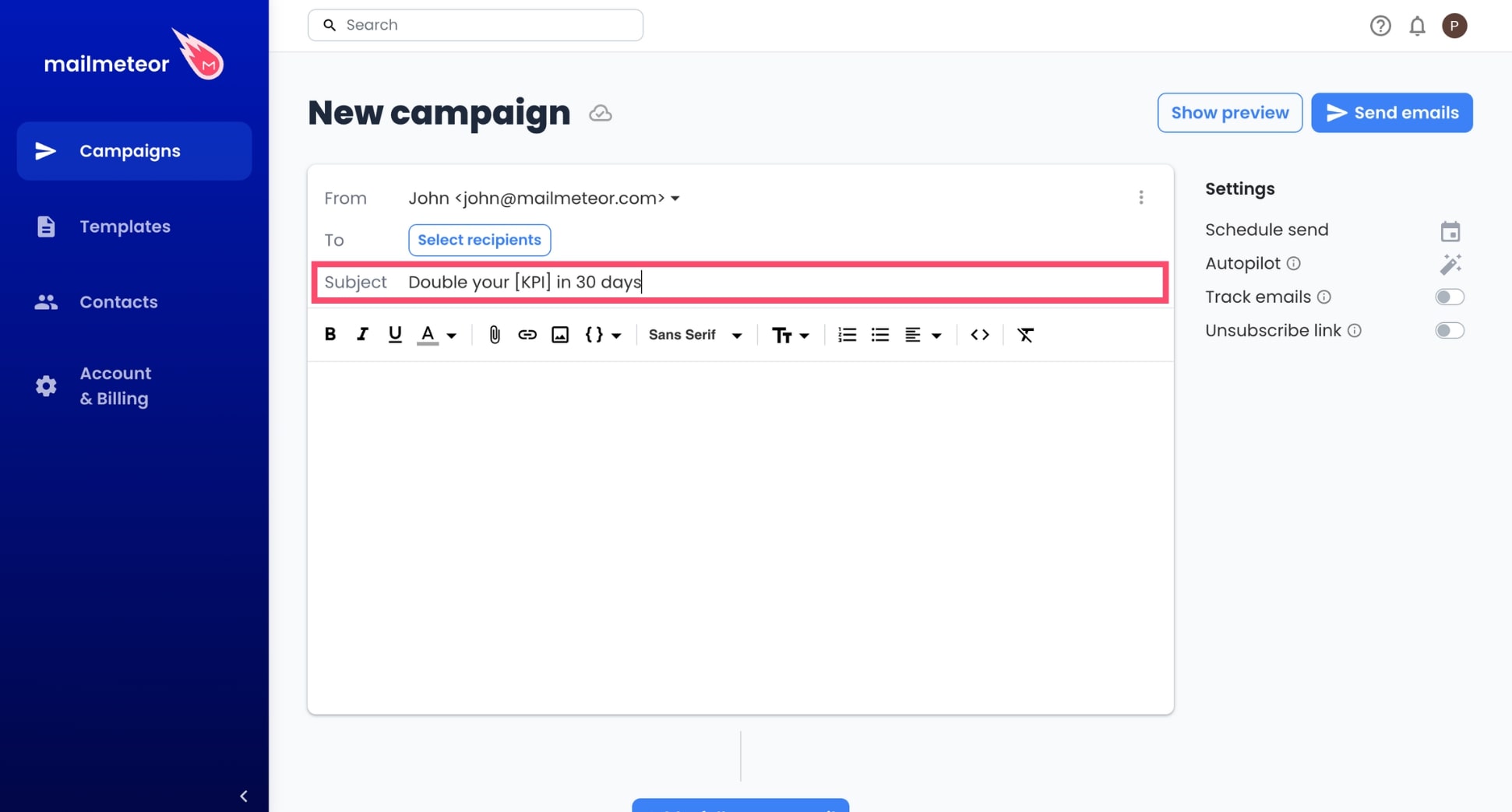
When to use it:
Use benefit-driven subject lines when you want to immediately highlight the value your product can bring to the recipient. This strategy is particularly effective when you have a clear understanding of what your prospect values most.
Why it works:
These cold email subject lines appeal directly to the recipient’s self-interest and answer the critical question , “What’s in it for me?” before the recipient even opens the message. By focusing on what the prospects stand to gain, you give them a compelling reason to open your cold email.
Examples:
- Save 10 hours a week on [Task]
- Boost your [Metric] by 50%
- Reduce [Expense] by 30% - here’s how
- Double your [KPI] in 30 days
- Grow your [Business Area] without [Sacrifice]
- Simplify [Process] in 3 easy steps
- Streamline [Process] and save $[Amount]
- Get [Result] in just [Time]
- Slash meeting times in half
- Generate 3x more [Result]
- Unlock hidden [Benefit]
- Automate 80% of your [Repetitive Task]
- Secure 20% more leads this quarter
- Triple your ROI on [Business Area]
- Achieve [Goal] faster with [Solution]
- Drive growth in [Specific Area] without extra resources
- Enhance [Key Area] with zero extra effort
- Supercharge your [Department] with [New Approach]
5. Curiosity-inducing subject lines
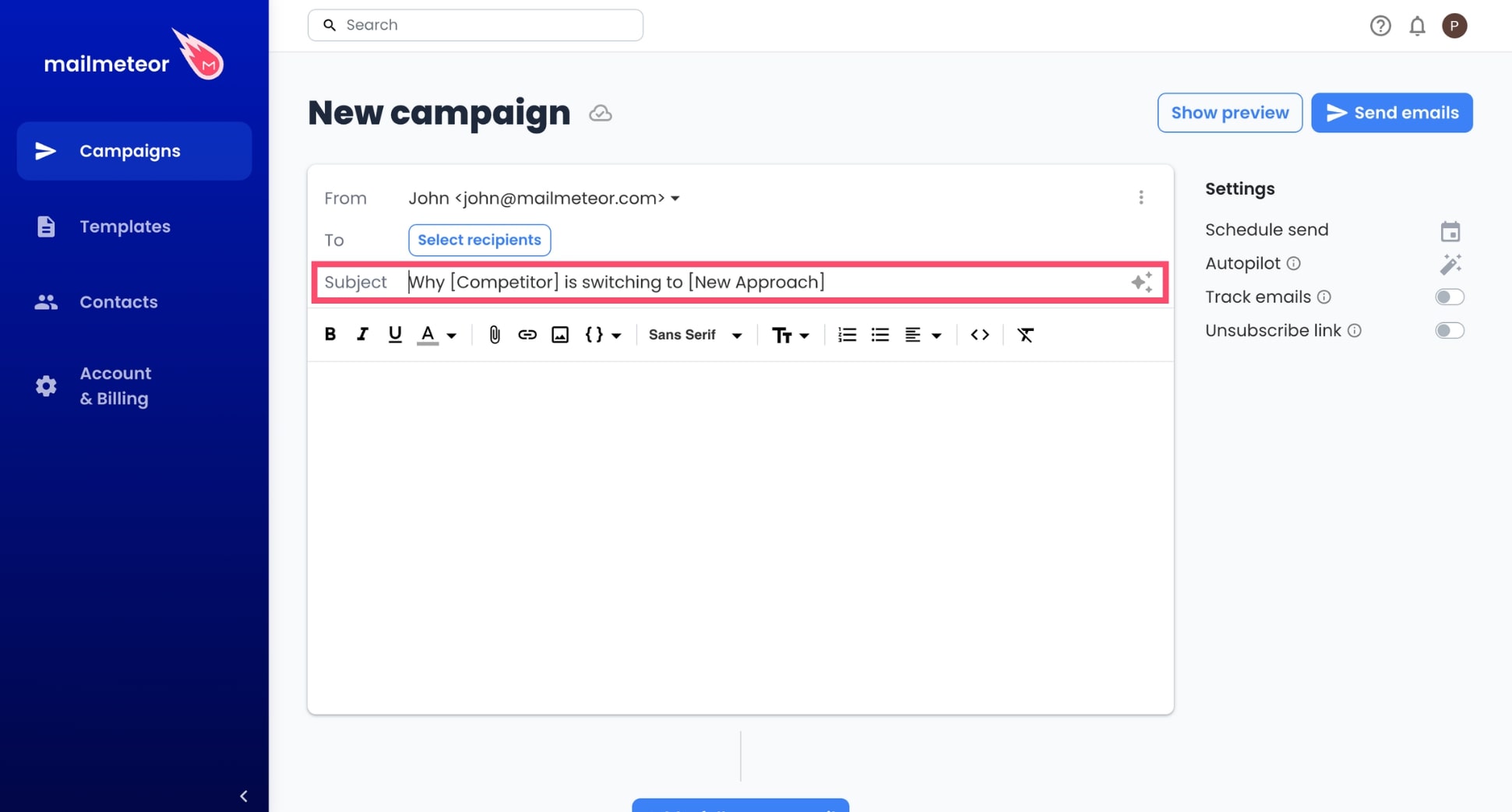
When to use it:
Use curiosity-inducing subject lines when you want to create intrigue and compel your recipients to open your email to satisfy their curiosity. This works great when you have a surprising insight to share. Just don’t give in to clickbait.
Why it works:
Curiosity is a powerful psychological trigger. By creating an information gap, these cold email subject lines tap into the recipient’s natural desire to resolve uncertainty and learn something new or unexpected.
Examples:
- This weird trick boosted our [Metric] by 200%
- Here’s what you might be missing in [Process]
- The most overlooked strategy in [Field]
- Are you making this costly [Industry] mistake?
- A new way to look at [Challenge]
- What [Successful Company] does differently – and why it works
- You’ve been doing [Task] all wrong – here’s why
- Why [Common Practice] might be holding you back
- We analyzed [Number] of [Data Points] and found this
- This tiny change yielded massive results
- This old-school tactic is making a comeback in [Industry]
- Why [Competitor] is switching to [New Approach]
- What [X%] of companies are getting wrong about [Topic]
- This one thing separates top [Industry] performers from the rest
- How [Surprising Tactic] led to [Result]
- A hidden opportunity in [Industry] you should know about
- The [Industry] hack nobody’s talking about
- What [Number] years of data reveal about [Topic]
6. Social proof subject lines
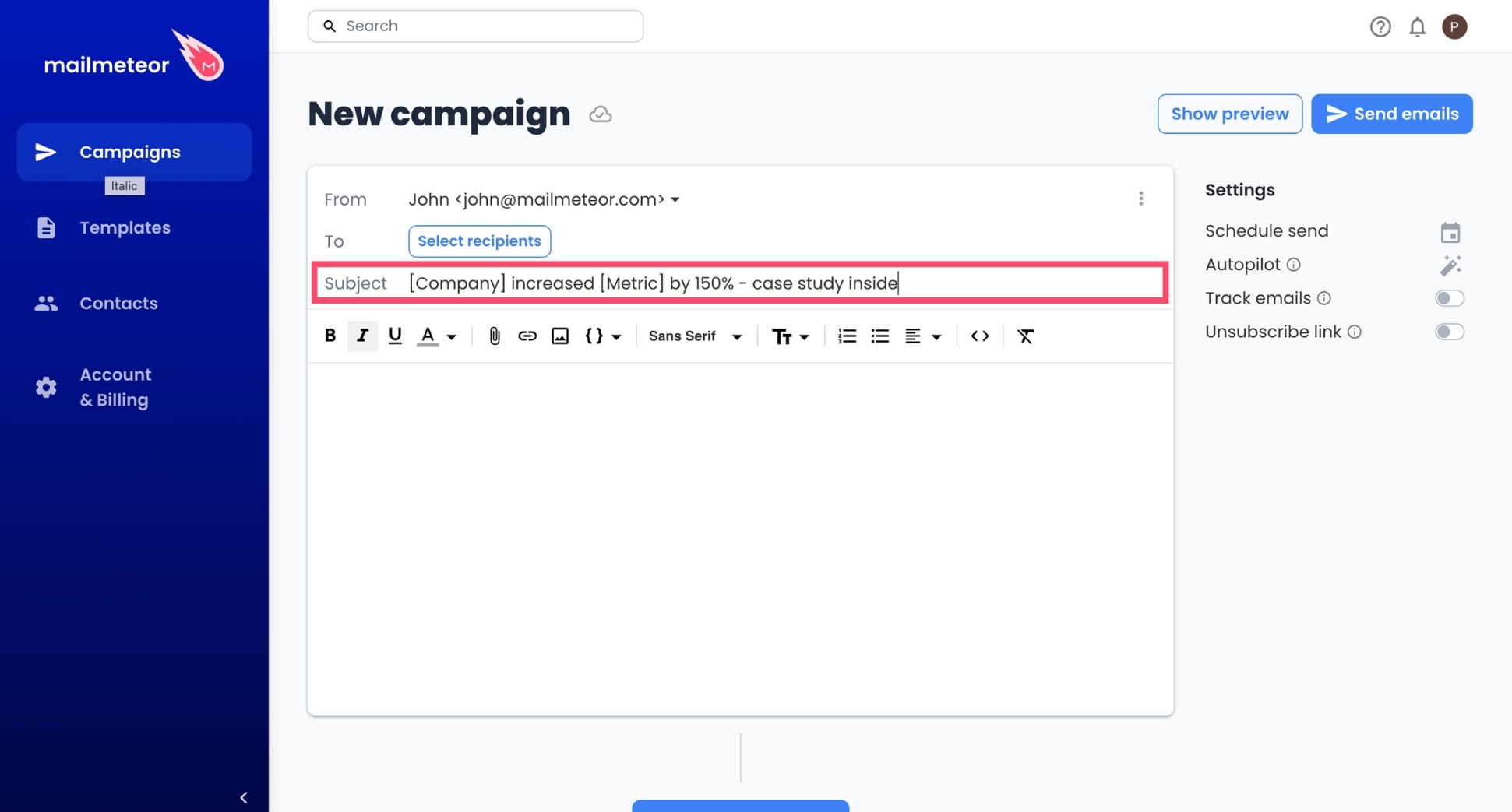
When to use it: Use social proof subject lines when you have evidence that your product or service is trusted by recognizable names in your prospect’s industry. This approach works well when you have impressive client results, testimonials from industry leaders, or significant user numbers to showcase. Why it works:
Social proof is another powerful psychological principle. People tend to look to others for cues about how to think and act, especially when they’re uncertain. By highlighting that others have found value in your offer, you can increase the likelihood that the recipient will respond to your cold email.
Examples:
- How [Number] companies are getting [Result]
- The overlooked tactic [Industry Leader] is using
- Why [Number] startups switched to [Product] this year
- How [Competitor] achieved [Result] with our solution
- [Industry Leader] called this a “game-changer”
- 95% of our clients report [Positive Outcome]
- [Company] increased [Metric] by 150% - case study inside
- How [Company] solved [Problem] for [Customer]
- [Number] [Industry] experts can’t be wrong about this
- [Well-Known Brand] solved [Problem] – here’s how
- The method [Number] of your peers are using for [Outcome]
- Curious how [Top Brand] tackled [Challenge]?
- Why [Product] is trusted by 8 out of 10 Fortune 500 companies
- The tool that [Number] [Industry] professionals swear by
7. Urgency and scarcity subject lines

When to use it:
Use urgency and scarcity subject lines when you have a genuine time-sensitive offer or limited availability. This approach is ideal for special promotions, exclusive deals, or when you’re trying to prompt quick action from your recipients.
Why it works:
Urgency and scarcity tap into the fear of missing out (FOMO). When people believe an opportunity is limited, either by time or availability, they’re more likely to act quickly to avoid losing out. These cold email subject lines create a sense of immediacy that can drive higher open rates and faster responses.
Examples:
- Last chance: [Offer] ends at midnight
- Only 5 spots left for [Event]
- 24-hour flash sale on [Product]
- Exclusive offer for [Company] - expires soon
- [Offer] closing in 3, 2, 1…
- Limited slots: Be one of [Number] to get [Benefit]
- Today only: [Offer] for [Company]
- Final hours to access [Exclusive Deal]
- [Name], claim your spot before it’s gone
- Exclusive [Industry] intel - available for 48 hours only
- Final call for [Benefit] - don’t be left behind
- [Product] prices increase next week - lock in now
- Hurry! Early bird pricing ends [Date]
- [Name], grab this deal before it disappears
- Just [Number] hours left to claim [Offer]
- Last chance to save on [Product]
- Time’s almost up - don’t miss out
- Last day to access [Limited-Time Offer]
A simple 5-step process to optimize your cold email subject lines
Creating a subject line for your cold emails is only the first step. Your job is then to test this subject line, collect data, and optimize it. Here’s a 5-step process that you can use to create high-ROI subject lines, refine your cold email strategy, and get more clicks, opens, and replies.
1. Use an AI subject line tester
Got a subject line for your next cold email? But you’re not sure if it’s any good? Use our free subject line tester. This tool scores your email subject line and gives you AI-powered suggestions to improve it.

Tests are made at multiple levels: length, number of words, number of question marks and exclamation points, presence of emojis, or spam words… Use this simple tool to create cold email subject lines that resonate with your audience.
2. Match with preheaders
The preheader is a snippet of text that appears next to the subject line in most email clients. It’s essentially a preview of your email content. So make sure your preheader complements your subject line, rather than repeating it.
A well-crafted preheader can provide additional context or intrigue and encourage recipients to open your email. So think of your subject line and preheader as a dynamic duo working together to boost open rates.
3. Send test emails
Most cold email platforms have a feature that lets you send test emails to yourself and your coworkers. This is a good opportunity to check how your subject line appears in different email clients and devices.
Make sure your subject line isn’t truncated on mobile devices. After running some tests on multiple email campaigns, we recommend to keep it within 30 to 50 characters or 4 to 7 words.
4. Run A/B tests
A/B testing, also known as split testing, is the best way to optimize your subject lines and get to know what resonates the most with your audience.
The idea is to create two versions of your cold email subject line, and send each version to a subset of your email list.
By comparing the performance of these two versions, you can collect valuable data, and refine your approach over time.
Make sure to test only one variable at a time (e.g., length, personalization, use of numbers) to get clear, actionable insights.
5. Track key metrics
Once you’ve pressed send, make sure to monitor the performance of your cold email campaigns. With tools like Mailmeteor, you can track key metrics in real-time, including email opens, clicks, replies, bounces, and unsubscribes.
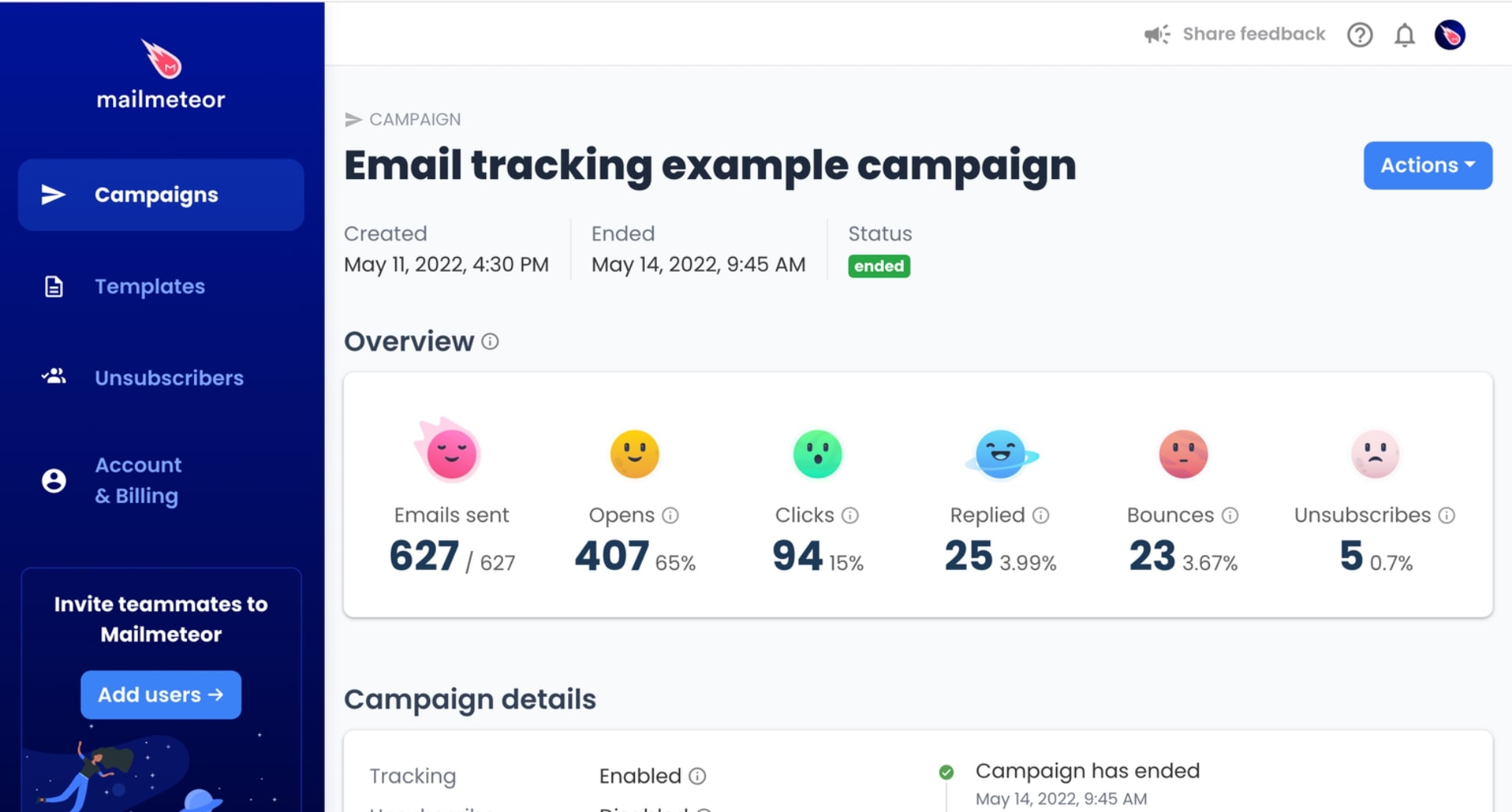
When it comes to cold email subject lines, two metrics stand out:
- Open rates: Your subject line’s primary job is to entice recipients to open your emails. If you’re seeing low open rates, it’s a clear signal to revisit your subject line strategy. Experiment with different strategies.
- Reply rates: While high open rates are great, they’re not the end goal. If your subject line is clickbait, you might see high opens but few replies. Make sure that your subject line accurately reflects your email content.
By consistently analyzing these metrics, you can refine your approach over time. Look for patterns in what works best for your specific audience. Are they responding more to personalization? Question-based subject lines? Benefit-driven approaches?
The bottom line
In this quick guide, we’ve shared 7 battle-tested strategies that you can use to craft cold email subject lines that get responses.
We’ve also given you 120+ customizable examples of effective subject lines for your next cold email campaigns.
But more importantly, we’ve explained the psychological principles at work behind each of these strategies.
Make sure to use this knowledge to refine, test, and optimize your subject lines until your cold emails become impossible to ignore.
Want to level up your cold outreach game? Check out our mini course on how to write cold emails that turn leads into deals.
To get started, you can also create your Mailmeteor account in 2 clicks. Our free plan lets you send up to 50 customized cold emails a day.
You can also track the performance of your messages, schedule follow-ups, embed videos directly into your emails, and so much more.
Happy sending 💌


